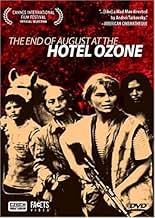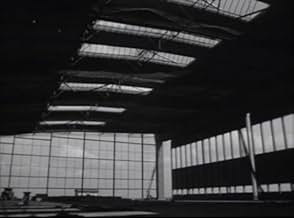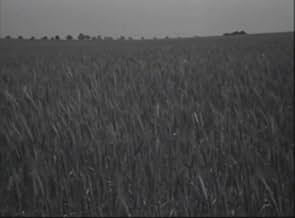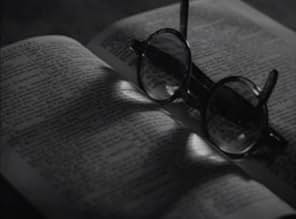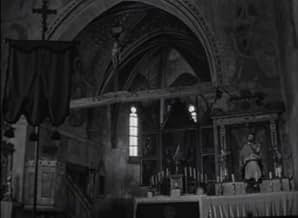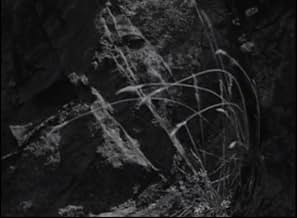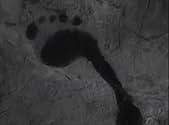IMDb RATING
6.6/10
670
YOUR RATING
A troupe of young women on post-apocalyptic earth are lead around by a mistress born before the war, eventually stumbling into the company of a lonely old man.A troupe of young women on post-apocalyptic earth are lead around by a mistress born before the war, eventually stumbling into the company of a lonely old man.A troupe of young women on post-apocalyptic earth are lead around by a mistress born before the war, eventually stumbling into the company of a lonely old man.
Featured reviews
I remember seeing a small handbill in a college basement around 1980. One of the films to be screened was THE END OF AUGUST AT THE HOTEL OZONE. The title intrigued, but, being the typical "too busy College Student" I did not attend the showing. So, for about a quarter century the title just lingered in my memory. Unreachable. I've NEVER heard of it screening anywhere, playing on TV or available on video or DVD (even in bootleg form). The title itself was so tantalizing, promising perhaps something apocalyptic (END OF "THE WORLD" not "AUGUST" perhaps?) or mysterious (a Hotel in the Ozone Layer?). And, of course, its sheer scarcity could only enhance the mystery, the suspense. Then, there it was in the American Cinematheque schedule. Oh, NO, I wasn't going to miss it this time! I had been up for work since 4 AM (!) and had worked a full 12 hour day. But, I was NOT to be denied! While the film does not quite live up to its evocative title (there was no reasonable way it could), it's still a fine Eastern European contribution to the Post-Nuke, End-Of-The-World and Lord of the Flies sub-genre(s).
After an oblique reference to the Nuclear calamity that man inflicted upon itself some 15 years earlier, the film proper begins slowly as we come to find a band of young, presumably fertile women, led by a wise old sage. I emphasize the word slowly, because the pace is off-putting at first. Events do happen and we get a picture of the women's pathetic and lonely existence. I particularly admired the fact that they are not scrubbed clean, shaved, manicured and primped and prettified as they doubtless would have been in an American production - Remember all those "lost women" films where the tribal women look like beauty contestants (indeed a couple of the actresses are very attractive, just unkempt)?! But, the glacial pacing is almost enough to drive most viewer's patience beyond the brink. Once the group stumbles upon an old man and his "Hotel Ozone", the film comes into its own. While the viewer is naturally inclined to sympathize with the women (if they had been men would we be so accepting?) despite some cruel, savage and disturbing activities (particularly towards animals), slowly we come to see a fuller and less positive view towards them. This reversal is doubtless intentional and packs a strong visceral punch. The final images of this band of lost ladies wandering a barren landscape is both heart-breaking and depressingly believable.
It's to the film's credit that we are not given a false or tidy ending: Befitting a title as gloriously ambiguous as THE END OF AUGUST AT THE HOTEL OZONE.
After an oblique reference to the Nuclear calamity that man inflicted upon itself some 15 years earlier, the film proper begins slowly as we come to find a band of young, presumably fertile women, led by a wise old sage. I emphasize the word slowly, because the pace is off-putting at first. Events do happen and we get a picture of the women's pathetic and lonely existence. I particularly admired the fact that they are not scrubbed clean, shaved, manicured and primped and prettified as they doubtless would have been in an American production - Remember all those "lost women" films where the tribal women look like beauty contestants (indeed a couple of the actresses are very attractive, just unkempt)?! But, the glacial pacing is almost enough to drive most viewer's patience beyond the brink. Once the group stumbles upon an old man and his "Hotel Ozone", the film comes into its own. While the viewer is naturally inclined to sympathize with the women (if they had been men would we be so accepting?) despite some cruel, savage and disturbing activities (particularly towards animals), slowly we come to see a fuller and less positive view towards them. This reversal is doubtless intentional and packs a strong visceral punch. The final images of this band of lost ladies wandering a barren landscape is both heart-breaking and depressingly believable.
It's to the film's credit that we are not given a false or tidy ending: Befitting a title as gloriously ambiguous as THE END OF AUGUST AT THE HOTEL OZONE.
This one heralds later works, Cormac Mccarthy's The Road and Michael Haneke's Time of the Wolf among them. It's a journey through a bleak barren landscape where characters are lost in it rather than found, set after an unspecified apocalypse that leaves the world an empty desolate place, not the end of the world like in an Emmerich film where destruction is an exciting spectacle to witness as but rather "an" end to the world, a hazy blur of abandonment filled with residues of mystery and nameless violence.
The film is a blank canvas. Distraught characters are violent and aimless. The land works by some other order. Where people like Herzog, Malick or Tarkovksy found things of spiritual importance to say on this other order, Schmidt's film is empty and distanced. When the film needs to be stark, animals are murdered for the camera, a dog is shot or a cow is slaughtered. The basic means of expression in The Road are poetic, here they are allegoric. As the characters of McCarthy's novel stagger starved and hopeless through the scorched macadam we can taste bitter ash in our mouths. Here they simply walk through shrubs. We don't fear for their souls, so to speak.
And then it gets interesting because the rugged band of amazons stumbles upon the ruins of an old hotel in the middle of the forest and there's an old man living there alone who sees in the young girls (all born after the apocalypse so they don't even have a word for "man" or "grammophone") a new future, new mothers for a new civilization of men. The first among the women, the leader, an old woman who was young before the apocalypse and can remember a time when "the cans didn't rust and the land didn't despise us", she doesn't allow herself to be dragged along on new hope, she is resigned to the end of times. The end is bleak and poignant, a hopeful future is not suggested, and the tiny pocket that preserves the civilization of the old world (where gramophones play music, where cows still make milk) is left behind to rot in the forest. What The End of August at the Hotel Ozone says about the communist regime of the time is at once vague enough to fool censors but clear in emotional duress.
This was a very interesting precursor to dystopian films that deal with the end of the world in sombre quiet terms. If it's not terribly successful it's because it's faintly groping in the dark where no one else had gone before, because it uses vague characters to sketch a very clear picture in allegory.
The film is a blank canvas. Distraught characters are violent and aimless. The land works by some other order. Where people like Herzog, Malick or Tarkovksy found things of spiritual importance to say on this other order, Schmidt's film is empty and distanced. When the film needs to be stark, animals are murdered for the camera, a dog is shot or a cow is slaughtered. The basic means of expression in The Road are poetic, here they are allegoric. As the characters of McCarthy's novel stagger starved and hopeless through the scorched macadam we can taste bitter ash in our mouths. Here they simply walk through shrubs. We don't fear for their souls, so to speak.
And then it gets interesting because the rugged band of amazons stumbles upon the ruins of an old hotel in the middle of the forest and there's an old man living there alone who sees in the young girls (all born after the apocalypse so they don't even have a word for "man" or "grammophone") a new future, new mothers for a new civilization of men. The first among the women, the leader, an old woman who was young before the apocalypse and can remember a time when "the cans didn't rust and the land didn't despise us", she doesn't allow herself to be dragged along on new hope, she is resigned to the end of times. The end is bleak and poignant, a hopeful future is not suggested, and the tiny pocket that preserves the civilization of the old world (where gramophones play music, where cows still make milk) is left behind to rot in the forest. What The End of August at the Hotel Ozone says about the communist regime of the time is at once vague enough to fool censors but clear in emotional duress.
This was a very interesting precursor to dystopian films that deal with the end of the world in sombre quiet terms. If it's not terribly successful it's because it's faintly groping in the dark where no one else had gone before, because it uses vague characters to sketch a very clear picture in allegory.
I saw this last night at the American Cinematheque as part of their tribute to screenwriter Pavel Juracek, and I have to say WOW. I was thoroughly impressed, completely engrossed from the first frame. The Cinematheque's schedule described this as "MAD MAX directed by Andrei Tarkovsky", which isn't far from the mark.
The actress who played the Old Lady, the leader of the amazons, has one of the most beautifully expressive faces I have ever seen onscreen, and this quality was only emphasized by the razor sharp black-&-white cinematography that brought out every tiny detail of emotional nuance. I found myself imagining that the Old Lady had been the teacher at an all-girl elementary school, and that after the Apocalypse she had merely extended her role of den mother into chief of the amazons' little tribe.
The actresses who play her young charges, nearly all apparently amateurs (only a few have any other film credits), are all attractive to a greater or lesser degree, but not in a slick, Hollywood way. They're like healthy, athletic peasant girls and farmer's daughters. Many appear to be expert equestrians - how to describe the thrill of seeing one of them mount a galloping horse sans saddle or stirrups? Of particular note is the young woman who played Barboura, the Old Lady's heir apparent, a statuesque red(?)head, a Balkan Sophia Loren. What a shame that she and nearly all of the other amazons made only this film and no others. They're all completely believable in their roles as young women transformed by the rigors and loneliness of their post-apocalyptic environment into hardened, even cruel near-barbarians (all without any male influence, mind you).
A word of caution for animal lovers: there all several scenes in which real animals - a snake, a cow - are actually killed onscreen, and very graphically. By today's standards this may seem callous, even evil, but in the context of the film I can understand how the filmmakers might have felt justified in doing so as these killings make the point of who these women are and what they've become (unlike, say, some of the egregious mondo thrills of onscreen animal slaughter in nearly every Italian cannibal film ever made). As for the dog mentioned by a previous reviewer, I'm uncertain whether or not it was killed. It may have been merely snared by one leg and pulled down to simulate its being shot, and it does appear to still be breathing after one of the amazons knocks its skull in just below the frameline; but it's hard for me to imagine an animal in such obvious distress being well-trained enough to suddenly go quiet after a 'pretend' blow to the head with a rifle butt. Besides, it's obviously a malnourished mutt and earlier in the film one of the actresses does connect with its head when she hurls a small log at it. Well, you can be the judge if you ever have a chance to see the film - which, if it does come up, I highly recommend you take.
The actress who played the Old Lady, the leader of the amazons, has one of the most beautifully expressive faces I have ever seen onscreen, and this quality was only emphasized by the razor sharp black-&-white cinematography that brought out every tiny detail of emotional nuance. I found myself imagining that the Old Lady had been the teacher at an all-girl elementary school, and that after the Apocalypse she had merely extended her role of den mother into chief of the amazons' little tribe.
The actresses who play her young charges, nearly all apparently amateurs (only a few have any other film credits), are all attractive to a greater or lesser degree, but not in a slick, Hollywood way. They're like healthy, athletic peasant girls and farmer's daughters. Many appear to be expert equestrians - how to describe the thrill of seeing one of them mount a galloping horse sans saddle or stirrups? Of particular note is the young woman who played Barboura, the Old Lady's heir apparent, a statuesque red(?)head, a Balkan Sophia Loren. What a shame that she and nearly all of the other amazons made only this film and no others. They're all completely believable in their roles as young women transformed by the rigors and loneliness of their post-apocalyptic environment into hardened, even cruel near-barbarians (all without any male influence, mind you).
A word of caution for animal lovers: there all several scenes in which real animals - a snake, a cow - are actually killed onscreen, and very graphically. By today's standards this may seem callous, even evil, but in the context of the film I can understand how the filmmakers might have felt justified in doing so as these killings make the point of who these women are and what they've become (unlike, say, some of the egregious mondo thrills of onscreen animal slaughter in nearly every Italian cannibal film ever made). As for the dog mentioned by a previous reviewer, I'm uncertain whether or not it was killed. It may have been merely snared by one leg and pulled down to simulate its being shot, and it does appear to still be breathing after one of the amazons knocks its skull in just below the frameline; but it's hard for me to imagine an animal in such obvious distress being well-trained enough to suddenly go quiet after a 'pretend' blow to the head with a rifle butt. Besides, it's obviously a malnourished mutt and earlier in the film one of the actresses does connect with its head when she hurls a small log at it. Well, you can be the judge if you ever have a chance to see the film - which, if it does come up, I highly recommend you take.
There isn't much of a story line in this film. But the characters and atmosphere are very effective.
There is one somewhat disturbing, but brief, sequence where a nice looking German shepherd dog is killed. I think they just simulated it's death by catching one of it's legs in a humane trap, but the dog's piteous yelps are still very heart rending.
The rest of the movie is very good, especially towards the end when the group of women are staying at the nearly abandoned hotel.
In a way, this movie was very well structured, even though there isn't much of story. It starts out slow and sets a scene, and then the plot thickens fairly smoothly and progressively towards the end. And it has a really tremendous ending, but I don't want to reveal it.
And, of course, the best thing about this movie are the feral young Amazonian women.
I'd love to have a copy of this film. It's a pity that it's out of print.
There is one somewhat disturbing, but brief, sequence where a nice looking German shepherd dog is killed. I think they just simulated it's death by catching one of it's legs in a humane trap, but the dog's piteous yelps are still very heart rending.
The rest of the movie is very good, especially towards the end when the group of women are staying at the nearly abandoned hotel.
In a way, this movie was very well structured, even though there isn't much of story. It starts out slow and sets a scene, and then the plot thickens fairly smoothly and progressively towards the end. And it has a really tremendous ending, but I don't want to reveal it.
And, of course, the best thing about this movie are the feral young Amazonian women.
I'd love to have a copy of this film. It's a pity that it's out of print.
The movie was made during the communist era and regardless of the directors/screenwriters political stance, the film definitely has a slighty disgusting, uncomfortable communist touch to it.
It's one of this films that nobody gets and that's gloomy, minimalist and hermetic. The characters speak in riddles and nothing ever happens, nor does anything ever get explained.
A "troupe" of barbarian like women (so much for communism) walks around through a desolate landscape and doesn't do much, as said before.
The only actual motif or repeating element in the film is the animal cruelty. Dogs are getting beaten (to death), women throw snakes around and at other women and horses are getting pulled by their mane.
Not of it ever makes sense or is getting explained. Needless to say that self professed armchair critics don't seem to have a problem with animal cruelty in this film (or when women are the perpetrators).
All in all this isn't even a good film for the usual undemanding b-movie-fans, sci-fi-nerds or other advocates of bad taste.
It's one of this films that nobody gets and that's gloomy, minimalist and hermetic. The characters speak in riddles and nothing ever happens, nor does anything ever get explained.
A "troupe" of barbarian like women (so much for communism) walks around through a desolate landscape and doesn't do much, as said before.
The only actual motif or repeating element in the film is the animal cruelty. Dogs are getting beaten (to death), women throw snakes around and at other women and horses are getting pulled by their mane.
Not of it ever makes sense or is getting explained. Needless to say that self professed armchair critics don't seem to have a problem with animal cruelty in this film (or when women are the perpetrators).
All in all this isn't even a good film for the usual undemanding b-movie-fans, sci-fi-nerds or other advocates of bad taste.
Did you know
- TriviaDana Medrická was originally considered for the part of Old Woman, eventually played by Beta Ponicanová.
- GoofsThe girls were born into a post-apocalyptic world, but at least one of them has a vaccination scar.
- ConnectionsEdited into CzechMate: In Search of Jirí Menzel (2018)
- How long is Late August at the Hotel Ozone?Powered by Alexa
Details
- Release date
- Country of origin
- Language
- Also known as
- Late August at the Hotel Ozone
- Production company
- See more company credits at IMDbPro
- Runtime1 hour 17 minutes
- Color
- Sound mix
- Aspect ratio
- 1.37 : 1
Contribute to this page
Suggest an edit or add missing content

Top Gap
By what name was Fin d'août à l'hôtel Ozone (1967) officially released in Canada in English?
Answer
